August Blooms
August Blooms
The final month of summer brings forth even more blooms and highlighting others. While wandering the gardens in August, be sure to look for a few of these late summer favorites.
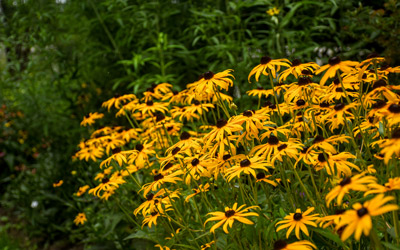
Brown-eyed coneflower (Rudbeckia spp.)
A staple of the mid-summer garden, Rudbeckia is a genus of around 20 species of annuals, biennials, and perennials that are native to North America. The coneflowers are daisy-like yellow flowers with brown-black centers atop mounded foliage. They are great plants for full sun areas.
Location(s): Throughout the Garden, primarily in the Lawn, Secret, and Entry Gardens, Garden of Inspiration, and Parking Garden
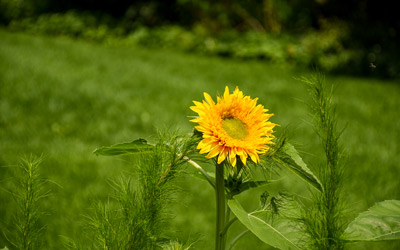
Sunflower (Helianthus annuus)
A classic annual grown for showy flowers of all sizes, sunflowers provide pops of color, are attractive to an array of pollinators, and come in an ever-expanding color palette. These plants love the heat of summer and are very easily grown from seed. Sunflowers will bloom at the Garden anytime from July through September.
Location(s): Winter, Climate, and Vegetable Gardens
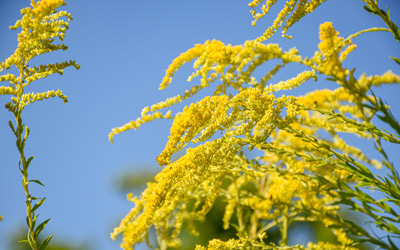
Goldenrod (Solidago spp.)
Goldenrod holds a special place in some hearts and is detested by others. There are more than 25 species of goldenrod in New England alone. Often —though unjustly— blamed for hay fever, goldenrod produces very little pollen, which itself is too heavy to be moved by the wind. Goldenrod, with its showy, bright yellow flowers, supports a large number of beneficial insects and is great as a late fall bloomer for pollinators. The plants will often bloom as early as late July and continue into October.
Location(s): Meadows, Secret Garden, and Beneficial Border
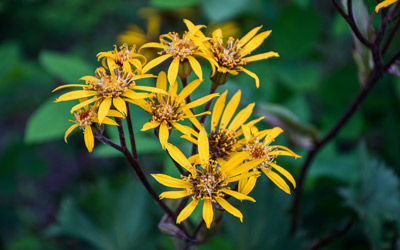
Leopard plant (Ligularia spp. and cultivars)
Most of the species in the Ligularia genus are native to Asia, especially Siberia, China, and Japan. The plants have daisy-like flowers that typically range in color from yellow to orange. These plants have dark foliage that presents a stark contrast to the blooms. They are usually in bloom from July through August.
Location(s): Along the Perennial Path of the Lawn Garden, in the Entry and Cottage Gardens, and Garden of Inspiration
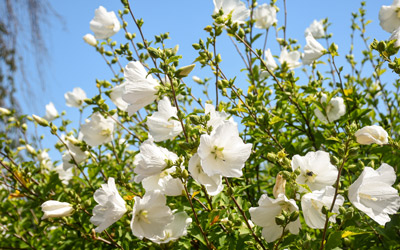
Rose of Sharon (Hibiscus syriacus ‘Diana’)
A vigorous, deciduous shrub, the rose of Sharon typically grows eight to 12 feet tall. The five-petaled white flowers can be up to three inches wide and appear over a long bloom period, often blooming from early summer to fall.
Location(s): The Lawn Garden
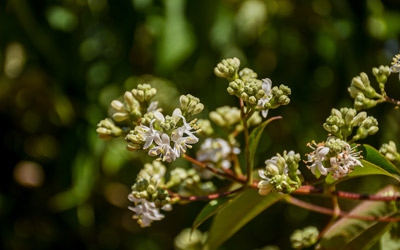
Seven-son flower (Heptacodium miconioides)
Originally introduced from China in 1980, this shrub has become popular in the Northeast. Seven son flower shrubs have fragrant blooms that arrive in August and September. The small, star-shaped flowers are produced in seven whorls, which lends to the shrub’s common name. In autumn, after the flowers fade, red-purple fruits appear.
Location(s): The Lawn and Winter Gardens
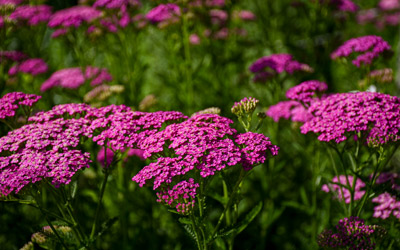
Yarrow (Achillea spp. and cultivars)
Species and hybrid plants within the Achillea genus are commonly used throughout gardens. These drought-tolerant plants are well-known for their fern-like foliage and vibrant colored mini flowers. Yarrow flowers can range from pink, red, white, gold, or yellow. The flat form of their flower structure makes them easily accessible to many different types of insect pollinators. An assortment of yarrow can be found at the Garden.
Location(s): Throughout the Garden, primarily in the formal garden spaces
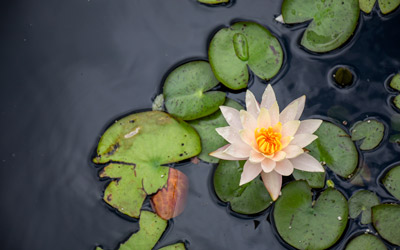
Water lily (Nymphaea spp. and cultivars)
Known and grown for their spectacular flowers, the Nymphaea genus features about 50 species of herbaceous aquatic perennials. The plants can be found worldwide and typically fall into one of two categories: winter-hardy or tropical. Winter-hardy water lilies tend to flower during the day, their flowers floating on the water, where tropical water lilies can flower day or night, their flowers extending above the water. The showy flowers can be pink, red, orange, yellow, purple, or white.
Location(s): Wildlife Refuge Pond, and in the garden pools of The Ramble, Winter and Secret Gardens
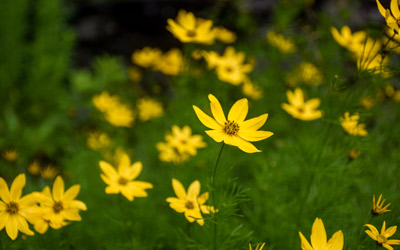
Tickseed (Coreopsis tripteris ‘Gold Standard’)
These tall, slender plants feature yellow, daisy-like flowers with brown center disks and eight yellow rays. Towering in size compared to other tickseed varieties, ‘Gold Standard’ grows five to six feet tall with its showy yellow flowers. The plant is great for pollinators in late summer, blooming from July to September.
Location(s): Lawn Garden
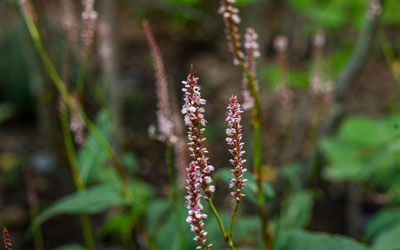
Knotweed (Persicaria spp.)
The herbaceous flowering plants of the Persicaria genus are commonly known as knotweeds. The flowers of the deciduous plants often range from white to pink or purple. A greenish or reddish hue can occur as well.
Location(s): Secret Garden, Beneficial Border, and The Ramble
